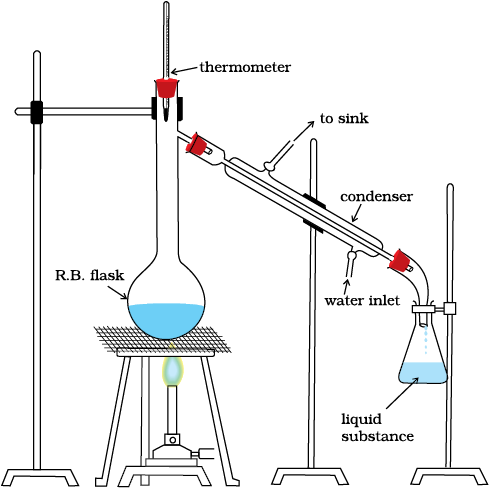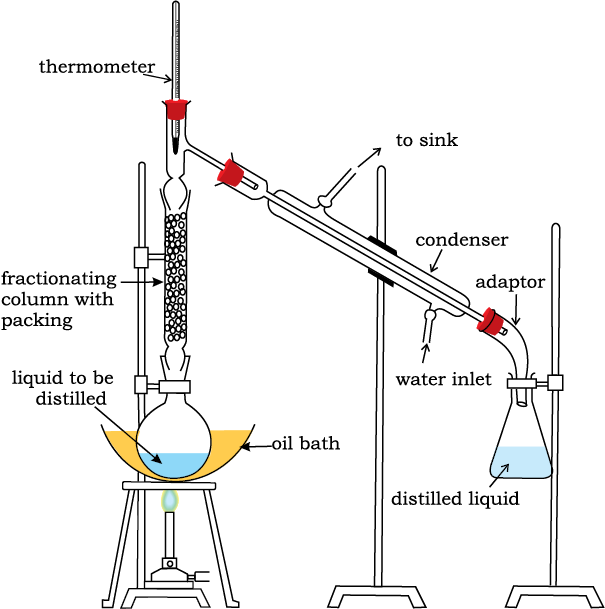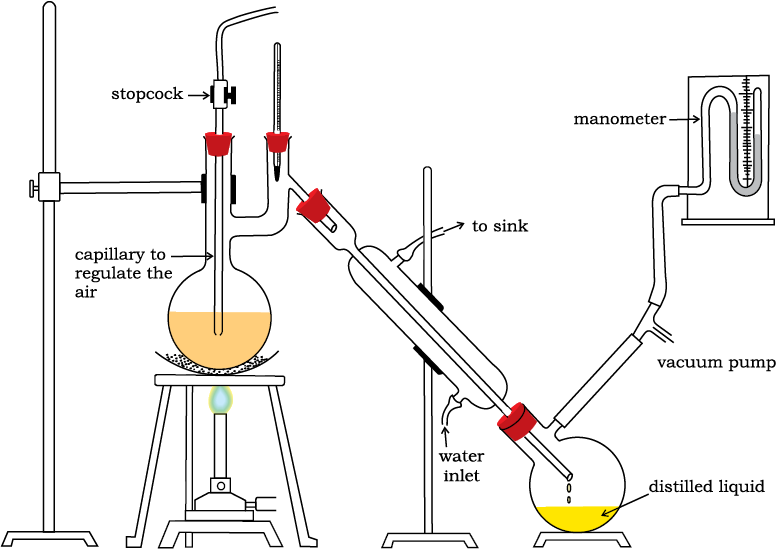Once an organic compound is extracted from a natural source or synthesised in the laboratory, it is essential to purify it. Various methods used for the purification of organic compounds are based on the nature of the compound and the impurity present in it.
The common techniques used for purification are as follows :
(i) Sublimation
(ii) Crystallisation
(iii) Distillation
(iv) Differential extraction and
(v) Chromatography
Finally, the purity of a compound is ascertained by determining its melting or boiling point. Most of the pure compounds have sharp melting points and boiling points. New methods of checking the purity of an organic compound are based on different types of chromatographic and spectroscopic techniques.
12.8.1 Sublimation
You have learnt earlier that on heating, some solid substances change from solid to vapour state without passing through liquid state. The purification technique based on the above principle is known as sublimation and is used to separate sublimable compounds from non-sublimable impurities.
This is one of the most commonly used techniques for the purification of solid organic compounds. It is based on the difference in the solubilities of the compound and the impurities in a suitable solvent. The impure compound is dissolved in a solvent in which it is sparingly soluble at room temperature but appreciably soluble at higher temperature. The solution is concentrated to get a nearly saturated solution. On cooling the solution, pure compound crystallises out and is removed by filtration. The filtrate (mother liquor) contains impurities and small quantity of the compound. If the compound is highly soluble in one solvent and very little soluble in another solvent, crystallisation can be satisfactorily carried out in a mixture of these solvents. Impurities, which impart colour to the solution are removed by adsorbing over activated charcoal. Repeated crystallisation becomes necessary for the purification of compounds containing impurities of comparable solubilities.
This important method is used to separate (i) volatile liquids from nonvolatile impurities and (ii) the liquids having sufficient difference in their boiling points. Liquids having different boiling points vaporise at different temperatures. The vapours are cooled and the liquids so formed are collected separately. Chloroform (b.p 334 K) and aniline (b.p. 457 K) are easily separated by the technique of distillation (Fig 12.5). The liquid mixture is taken in a round bottom flask and heated carefully. On boiling, the vapours of lower boiling component are formed first. The vapours are condensed by using a condenser and the liquid is collected in a receiver. The vapours of higher boiling component form later and the liquid can be collected separately.

Fig.12.5 Simple distillation. The vapours of a substance formed are condensed and the liquid is collected in conical flask.
Fractional Distillation: If the difference in boiling points of two liquids is not much, simple distillation cannot be used to separate them. The vapours of such liquids are formed within the same temperature range and are condensed simultaneously. The technique of fractional distillation is used in such cases. In this technique, vapours of a liquid mixture are passed through a fractionating column before condensation. The fractionating column is fitted over the mouth of the round bottom flask (Fig.12.6, page 358).

Fig.12.6 Fractional distillation. The vapours of lower boiling fraction reach the top of the column first followed by vapours of higher boiling fractions.
Vapours of the liquid with higher boiling point condense before the vapours of the liquid with lower boiling point. The vapours rising up in the fractionating column become richer in more volatile component. By the time the vapours reach to the top of the fractionating column, these are rich in the more volatile component. Fractionating columns are available in various sizes and designs as shown in Fig.12.7. A fractionating column provides many surfaces for heat exchange between the ascending vapours and the descending condensed liquid. Some of the condensing liquid in the fractionating column obtains heat from the ascending vapours and revaporises. The vapours thus become richer in low boiling component. The vapours of low boiling component ascend to the top of the column. On reaching the top, the vapours become pure in low boiling component and pass through the condenser and the pure liquid is collected in a receiver. After a series of successive distillations, the remaining liquid in the distillation flask gets enriched in high boiling component. Each successive condensation and vaporisation unit in the fractionating column is called a theoretical plate. Commercially, columns with hundreds of plates are available.
One of the technological applications of fractional distillation is to separate different fractions of crude oil in petroleum industry.
Distillation under reduced pressure: This method is used to purify liquids having very high boiling points and those, which decompose at or below their boiling points. Such liquids are made to boil at a temperature lower than their normal boiling points by reducing the pressure on their surface. A liquid boils at a temperature at which its vapour pressure is equal to the external pressure. The pressure is reduced with the help of a water pump or vacuum pump (Fig.12.8). Glycerol can be separated from spent-lye in soap industry by using this technique.

Fig.12.7 Different types of fractionating columns.
Fig.12.8 Distillation under reduced pressure. A liquid boils at a temperature below its vapour pressure by reducing the pressure.

Steam Distillation: This technique is applied to separate substances which are steam volatile and are immiscible with water. In steam distillation, steam from a steam generator is passed through a heated flask containing the liquid to be distilled. The mixture of steam and the volatile organic compound is condensed and collected. The compound is later separated from water using a separating funnel. In steam distillation, the liquid boils when the sum of vapour pressures due to the organic liquid (p1) and that due to water (p2) becomes equal to the atmospheric pressure (p), i.e. p =p1+ p2. Since p1 is lower than p, the organic liquid vaporises at lower temperature than its boiling point.
Thus, if one of the substances in the mixture is water and the other, a water insoluble substance, then the mixture will boil close to but below, 373K. A mixture of water and the substance is obtained which can be separated by using a separating funnel. Aniline is separated by this technique from aniline – water mixture (Fig.12.9, Page 360).